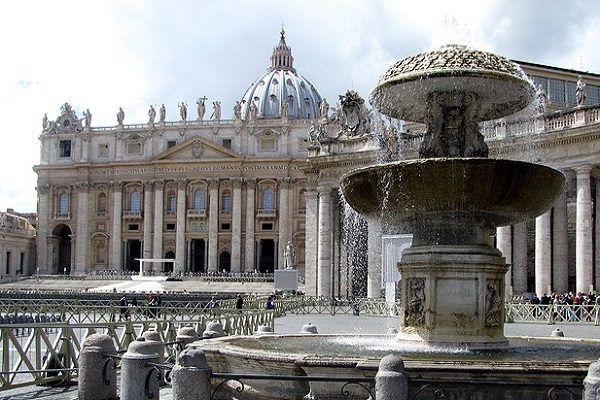
Is the Catholic Church Experiencing Exponential Growth or Declining?
- By Kelly Frazier --
- 09 Mar 2016 --

A comparative analysis on the contrasting poll results on the world population of Catholics.
The Catholic Church is composed of one of the biggest, most influential populations in the United States and around the world. With its leader, Pope Francis, becoming increasingly popular among Catholics, Protestants and unaffiliated people alike, Catholicism is certainly a force to be reckoned with in both the religious and secular world.
Is the Catholic Church Experiencing Exponential Growth or Declining?[/tweetthis]
The Vatican recently released information that says that the number of Catholics have increased at an exponential rate, even faster than the world population. The Catholic News Agency reports: “over the course of nine years, the number of Catholics worldwide has increased by 17.8 percent, compared to the global population, which increased by 17.3 percent.” It was likewise reported that from 2005-2014, the growth of the Catholic populace jumped from 1.12 billion to 1.27 billion. The African continent saw the greatest increase at 41 percent, while its population grew at 23.8 percent. Asia’s Catholic population grew at 20 percent versus a 9.6 percent population growth. The United States had 11.7 percent Catholic growth compared to 9.6 percent population growth. A Global Pew Report on the Catholic Population showed that Catholics have grown from an estimated 291 million in 1910 to nearly 1.1 billion as of 2010.
Apart from the increase in members of the Catholic Church, those serving the Catholic public have also increased. The Catholic News Agency reports: “the statement also notes a global increase in the number of bishops from 2005-204, although America and Oceania saw a slightly lower increase than the world average.” Diocesan and religious priests also saw a worldwide increase, while there was a decrease of the number of new priests in Europe and Oceania. The number of seminarians was also consistently high in Africa, Asia and Oceania, with Europe and America numbers declining.
The Catholic Church is growing at a rate faster than the general population. https://t.co/uvnjRafBLn
— robertfeduccia (@robertfeduccia) March 8, 2016
However, despite these overwhelmingly positive numbers, a Pew report shows a steady decline in American Catholics, while “other data show the number has stayed consistent.” According to the 2014 Pew Report, entitled America’s Changing Religious Landscape, “the Christian share of the U.S. population is declining, while the number of U.S. adults who do not identify with any organized religion is growing.” The significant new survey studied 35,000 Americans and found that the figure of adults, 18 and older, who call themselves Christian “has dropped by nearly eight percentage points in just seven years, from 78.4 percent in an equally massive Pew Research survey in 2007 to 70.6 percent in 2014.” While all this was occurring, the percentage of religiously unaffiliated Americans (meaning atheist, agnostic or nothing in particular) jumped more than six points, an increase from 16.1 percent to 22.8 percent. The number of those adhering to non-Christian faiths also increased.
Additionally, according to Pew, there were an estimated 51 million adult Catholics in the country in 2014, making up 20.8 percent of the adult population. However, in 2007, there were more Catholics at 54.3 million, consisting of 23.9 percent of adults. Taking this into consideration, the Catholic adult population fell by 1 million between the years 2007 and 2014.
The question is, how can we have such drastically opposing numbers from the Vatican and from the U.S.-based Pew study? OurSundayVistor Newsweekly claims that we cannot be sure that this shift actually occurred, upon review of alternative data sources. Mark Gray of the OSV Newsweekly acknowledges that “understanding changes in religious populations has always been challenging in the United States.” He cites historical facts that illuminate this point. In 1957, the Census Bureau queried the public about religious affiliation in the Current Population Survey (CPS), estimating a figure of 30.1 million Catholics in the country, aged 14 years and older. However, since 1976, the Census Bureau can no longer ask Americans about their religious affiliation, according to law. Compared to other countries, the United States does not possess a “religious census,” while religions have their own ways of keeping track of their own numbers. Churches may base data on “worship attendance counts, registration rolls, baptisms and deaths.” The caveat is that those who may not have a very active religious life are impossible to count.
The Catholic Church seems to have resigned itself to a continuing decline in the west https://t.co/z7Q3t3LniA
— Simon (@infinimprobable) February 13, 2016
The Catholic Church in the U.S. and the Vatican both keep track of membership figures. Interestingly enough, the figures produced by the church differ greatly from Pew Forum’s assertion of decline in the church. The church estimated 68.1 million adult and child Catholics in 2004, and 64.1 Catholics in 2007.
How do we come up with reliable data and reconcile the polar differences in information? According to OSV Newsweekly, “Beyond Church counts (and without a census), the best way to estimate the size of the adult Catholic population is to utilize aggregated polling. Researchers take the average across a number of polls, smoothing out variations related to margins of error and the individual practices of polling groups.” The answer is to extract and deduce the approximate closest number by putting several data sets together. For example, a meta-analysis of 275 national surveys was conducted by the Gallup Organization, the Public Religion Research Institute (PRRI), the Pew Research Center and the General Social Survey (GSS). The abovementioned groups utilize academic polling, commercial polling and private researching organizations. Beginning 2010, an estimated 23.2 percent of adults in the United States self-identified as belonging to the Catholic Church. The lowest figure of Catholic followers derived was 18.3 percent and the highest 27.5 percent.
Pew says that there were 50.9 million adult Catholics in 2014 and according to the GSS study, there were 62.1 million. It may be impossible to come up with a singularly accurate number, based on the varying processes and techniques employed to extract accurate figures, but we may be able to safely conclude that the number is “somewhere in between.” It is important to note: “the General Social Survey series, which began in 1972, does not show any significant prevailing trend up or down in the share of the adult population that is Catholic at any point.” Pew may be slightly off when it comes to claiming an indication of decline, as the Catholic population may just have remained the same. The Vatican numbers are a whole other story, as they project figures worldwide, spanning beyond the U.S. population, making it difficult to make a direct comparison with U.S.-focused studies and surveys. The U.S. is home to only about 7 percent of the Catholics in the world.



















